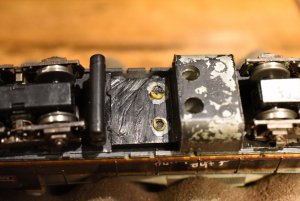IronBeltKen
Member
Hi gang,
I don't have any professional railroad experience - but I sure chased a lot of trains on the B&O throughout Maryland in the summers of 1971-72! My father gave me an old Voigtlander 35mm camera of his, which I immediately pressed into service for RR photography and got a modest collection of Kodachrome color slides. These sat in boxes in various attics over a 20-year period, and many were heat- and mold-damaged when I finally decided to retrieve them a few years back. I picked out some of the ones that were at least somewhat usable, and submitted them to ScanCafe - who captured them into JPEG images for a reasonable fee. I'll throw a few of them on here to start, and if y'all like them, I'll keep posting one or two more each day.
Here's a few of an SD9 I saw working Curtis Bay Yard (Baltimore MD) in the early summer of 1972:


These are tough to replicate as models due to the single fuel tank and the wide-open space under the frame - if you want powered units, that is. To replicate that open space, you'd need to mill away part of the underlying metal chassis where the motor is attached!
I don't have any professional railroad experience - but I sure chased a lot of trains on the B&O throughout Maryland in the summers of 1971-72! My father gave me an old Voigtlander 35mm camera of his, which I immediately pressed into service for RR photography and got a modest collection of Kodachrome color slides. These sat in boxes in various attics over a 20-year period, and many were heat- and mold-damaged when I finally decided to retrieve them a few years back. I picked out some of the ones that were at least somewhat usable, and submitted them to ScanCafe - who captured them into JPEG images for a reasonable fee. I'll throw a few of them on here to start, and if y'all like them, I'll keep posting one or two more each day.
Here's a few of an SD9 I saw working Curtis Bay Yard (Baltimore MD) in the early summer of 1972:
These are tough to replicate as models due to the single fuel tank and the wide-open space under the frame - if you want powered units, that is. To replicate that open space, you'd need to mill away part of the underlying metal chassis where the motor is attached!
Last edited:


